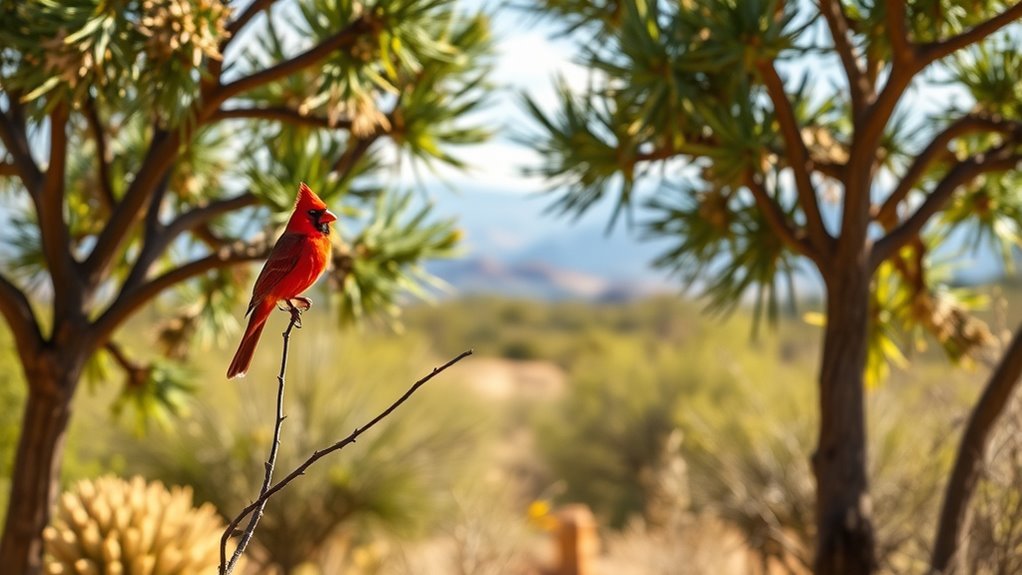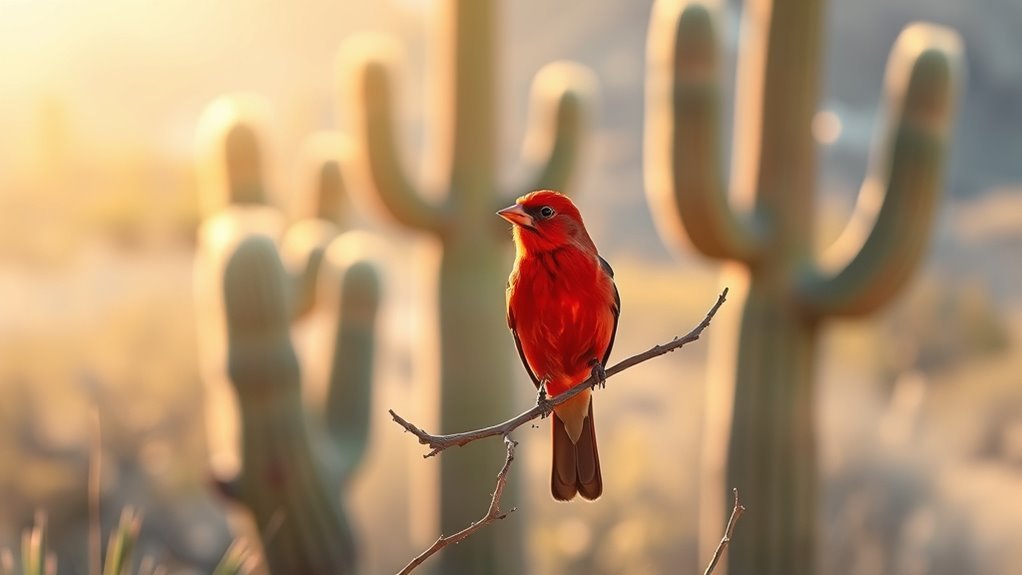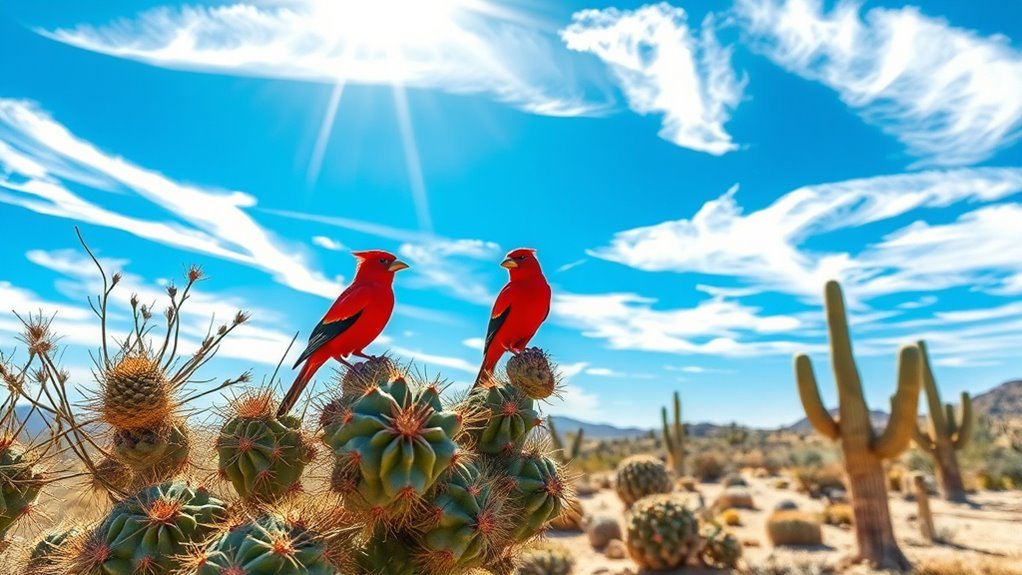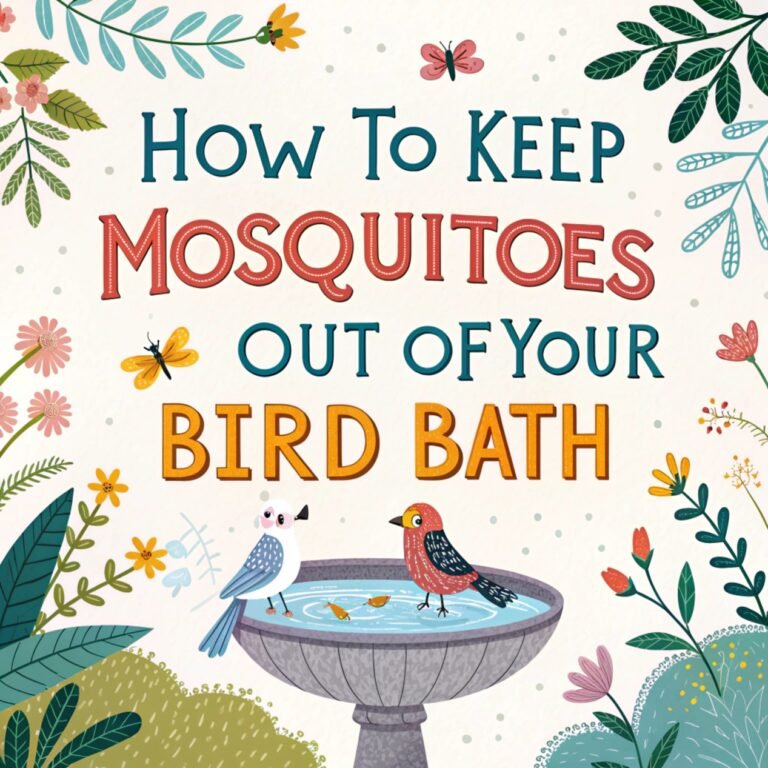Exploring Tucson’s Unique Avian Life Featuring Red Birds
Tucson is home to a variety of birds, especially red ones like the Northern Cardinal and Vermilion Flycatcher. These birds stand out due to their bright colors and important roles in nature. Watching their behavior in different environments helps us learn about bird life and the balance in ecosystems. Knowing more about these birds enhances our appreciation and raises questions about their survival and interactions in a changing world. Enjoying their beauty and understanding their habits can inspire a love for wildlife and nature.
Key Takeaways
- The Northern Cardinal's vibrant red feathers and melodic song attract birdwatchers across Tucson, especially at feeders with seeds and berries.
- The Vermilion Flycatcher showcases bright red plumage and agile hunting skills, often found in open woodlands and riverbanks.
- Sabino Canyon and Saguaro National Park are prime birdwatching spots, hosting diverse red bird species throughout the year.
- Red birds play vital roles in the ecosystem by aiding in seed dispersal and controlling insect populations.
- Early mornings and late afternoons are the best times for spotting red birds in Tucson; binoculars enhance the experience.
The Northern Cardinal: A Colorful Icon of Tucson
The Northern Cardinal is a bright red bird commonly seen in Tucson. Its colorful feathers and beautiful song make it easy to spot. This bird represents hope and joy, reflecting the connection many people have with nature.
Males are known for their vivid colors and loud calls, which they use to mark territory and attract mates. Cardinals usually build their nests in dense trees, offering protection for their chicks.
They frequently visit feeders to eat seeds and berries, providing bird watchers with a wonderful view. Watching these birds can deepen your appreciation for the Tucson environment and strengthen your community bonds through a shared love for these colorful creatures.
The Vermilion Flycatcher: A Dazzling Desert Jewel
The Vermilion Flycatcher is a small bird known for its bright red feathers. It stands out in Tucson's dry environment. This bird likes open woodlands and riverbanks, where it can find good spots to catch insects.
The Vermilion Flycatcher uses a special method to feed. It hovers in the air and quickly darts to catch flying insects, showing great skill and speed.
It prefers areas with low plants, which help it spot food while staying hidden from larger animals.
These birds are social and often chase each other in their territory. This creates an active and lively scene.
Watching the Vermilion Flycatcher can enrich your experience of Tucson's bird life and help you appreciate the beauty of the desert.
Best Birdwatching Locations in Tucson

Tucson offers several excellent spots for birdwatching. Locations like Sabino Canyon and Saguaro National Park have diverse habitats and attract many bird species.
In spring and fall, you can see migratory birds, such as warblers and flycatchers. The Santa Cruz River's wetlands and the riparian zones at Reid Park are great for finding waterfowl and shorebirds during migration peaks.
Each site helps you learn about bird ecology while allowing for close encounters with nature. Connecting with other birdwatchers builds a sense of community and enhances your experience with Tucson's unique bird life.
Enjoy the chance to connect with this lively environment!
The Importance of Red Birds in the Ecosystem
Red birds are important for their ecosystems. They help with seed dispersal by eating fruits and spreading seeds through their droppings. This process supports the growth of new plants.
Red birds also control insect populations by eating pests that can harm plants. This behavior helps maintain healthy plant communities.
Additionally, red birds are part of the food chain. They serve as food for larger predators, which helps share energy among different levels of the ecosystem.
Tips for Birdwatching and Photography in Tucson

When you plan a birdwatching trip in Tucson, consider the best times and places to see different species. Understanding the local environment and using proper birdwatching equipment will enhance your experience.
Here are some straightforward tips to help:
- Visit at the right time: Mornings and late afternoons offer the most bird activity.
- Pick great spots: Visit Sabino Canyon and Saguaro National Park for a wide variety of birds.
- Use good equipment: Binoculars and a reliable field guide will help you identify birds better.
- Learn photography skills: Be patient and use a zoom lens to take clear photos without bothering the birds.
Follow these tips to enjoy Tucson's diverse birdlife.
Frequently Asked Questions
What Time of Year Are Red Birds Most Commonly Seen in Tucson?
You can commonly see red birds in Tucson during their breeding season, which is spring to early summer. They migrate to this area to breed and set up their territories. Look out for them during this time for the best chance of spotting these vibrant birds.
Are There Any Specific Birdwatching Tours Offered in Tucson?
Yes, Tucson offers several birdwatching tours that provide guided experiences. These tours highlight local bird species and habitats. You will gain insights from experts, which will improve your understanding of the diverse birds in the area. These tours are a great way to connect with nature and enjoy the beauty of Tucson's avian life.
How Can I Attract Red Birds to My Backyard?
To attract red birds to your backyard, follow these simple steps:
- Install Bird Feeders: Use feeders filled with sunflower or safflower seeds. These seeds are favorites among red birds.
- Plant Native Plants: Grow native plants in your yard. They provide natural food sources and shelter for these birds.
- Create a Welcoming Space: Ensure your backyard is a safe and inviting environment. This will encourage red birds to visit regularly.
What Are Some Signs of Endangered Red Bird Species in Tucson?
You may see fewer red birds in Tucson due to habitat loss. Signs to watch for include fewer sightings, failed nests, and fewer breeding pairs. Conservation efforts are important. They help protect these birds and ensure their survival in Tucson. By supporting these efforts, you contribute to a healthier ecosystem for all species.
Can Red Birds Survive the Winter in Tucson?
Red birds can survive winter in Tucson. They have thicker feathers to help keep warm. They look for food and shelter. These skills help them thrive in colder months. You can admire their strength during this time.

Hello, I’m Amelia White, the founder of birdsfanatic.com. As a lifelong bird enthusiast and spiritual seeker, I’ve always been fascinated by the mystical connections between birds and the human experience. On this site, I share my knowledge and insights into the symbolic meanings and spiritual significance of various bird species, exploring their roles in mythology, folklore, and cultural traditions. Join me on this journey into the world of birds, where we’ll discover the hidden wisdom and guidance that these magnificent creatures have to offer.







